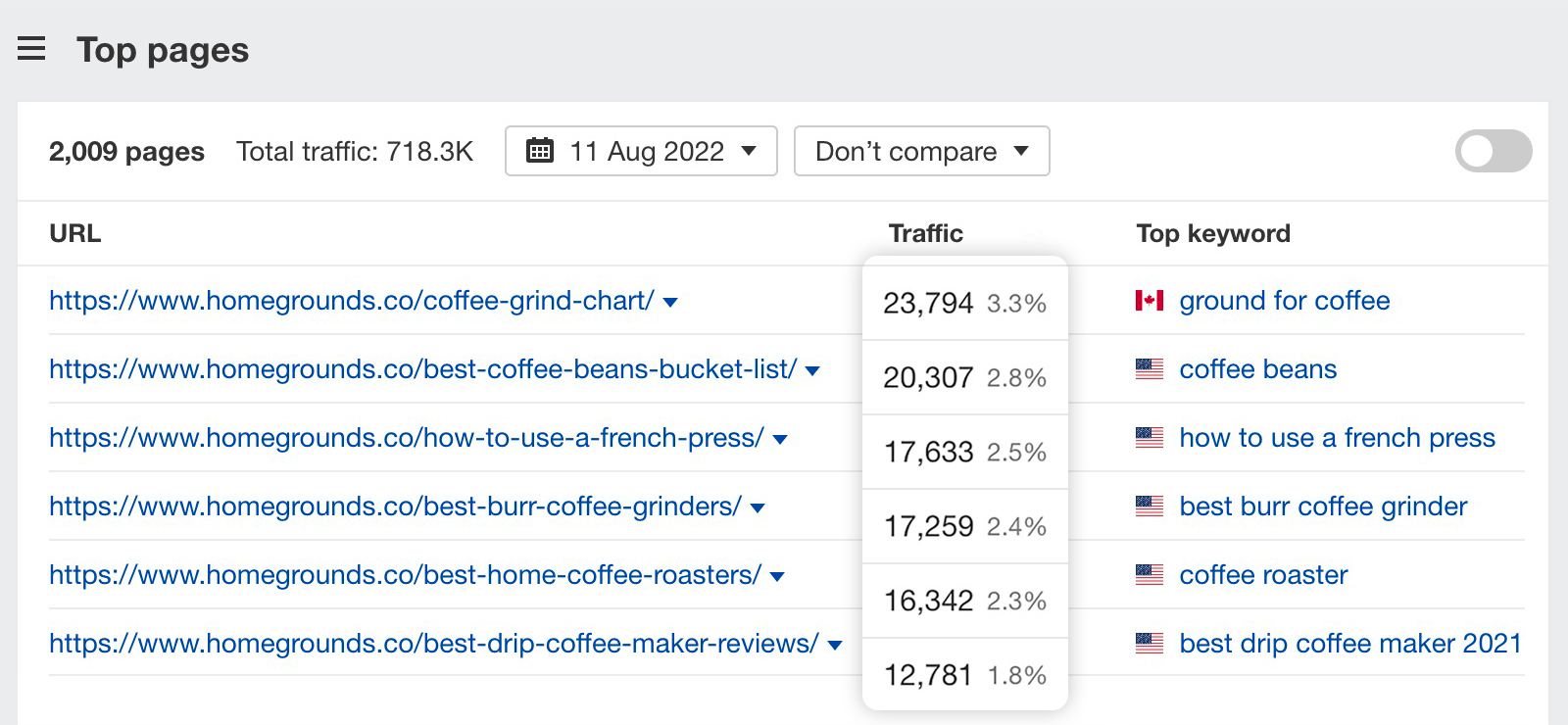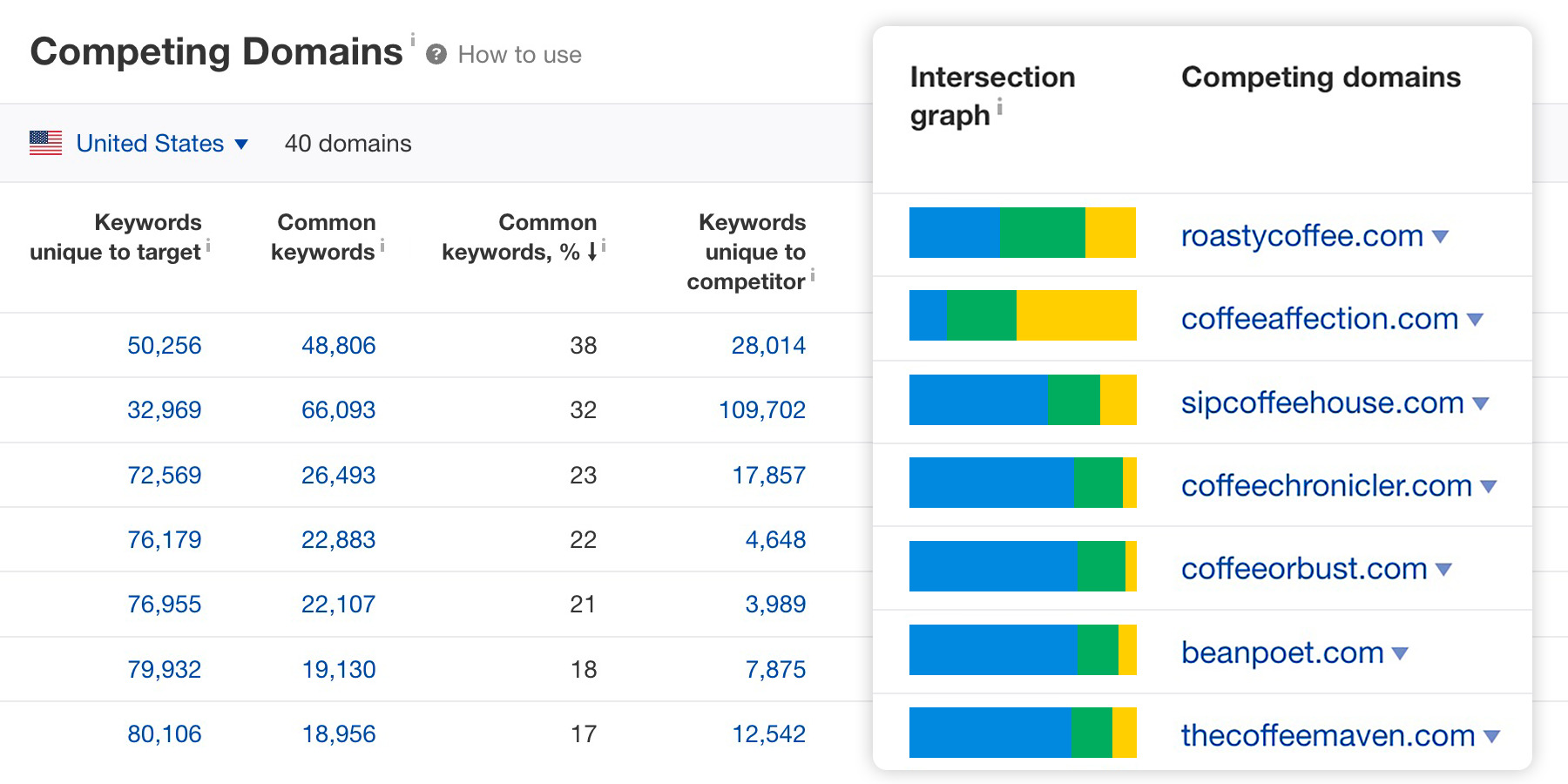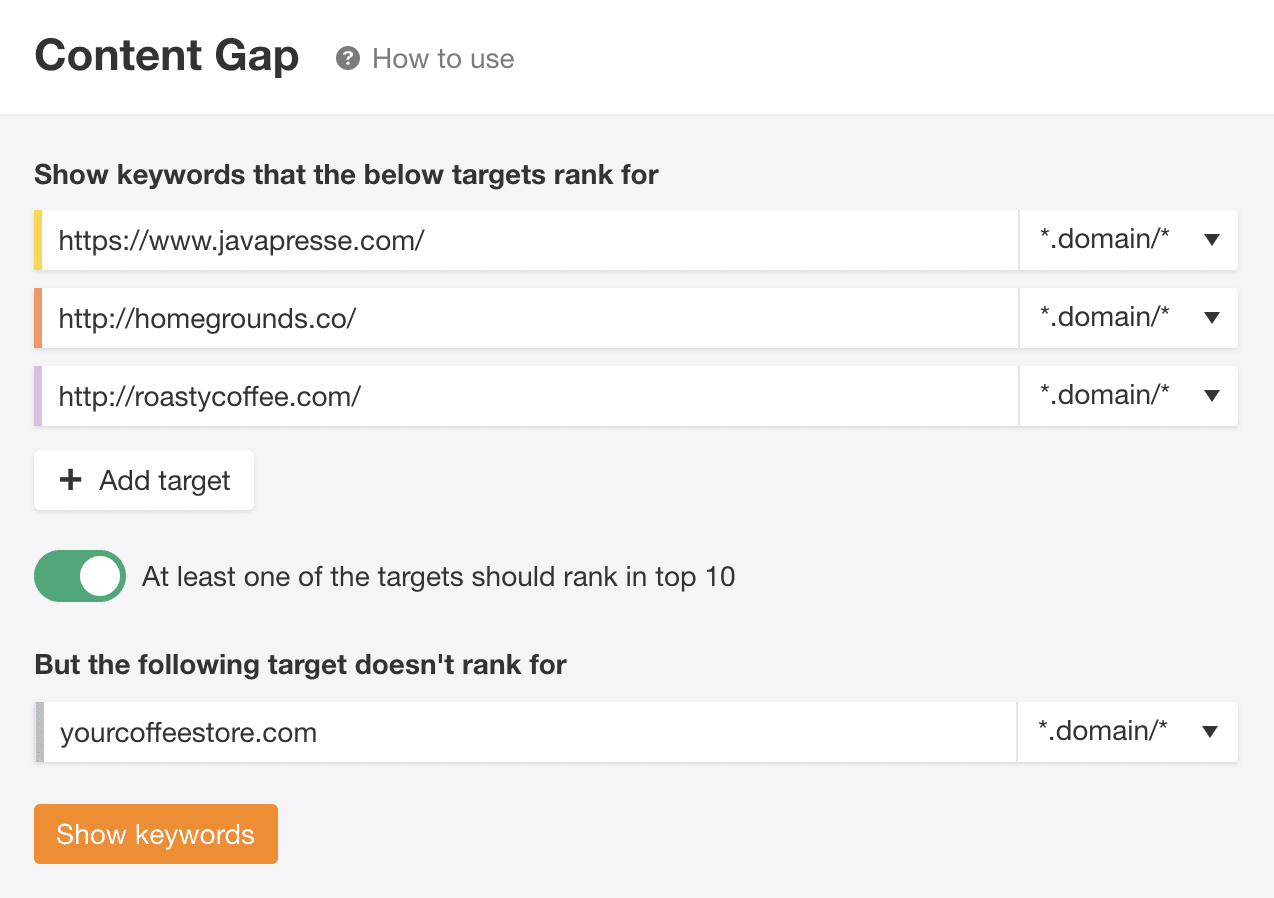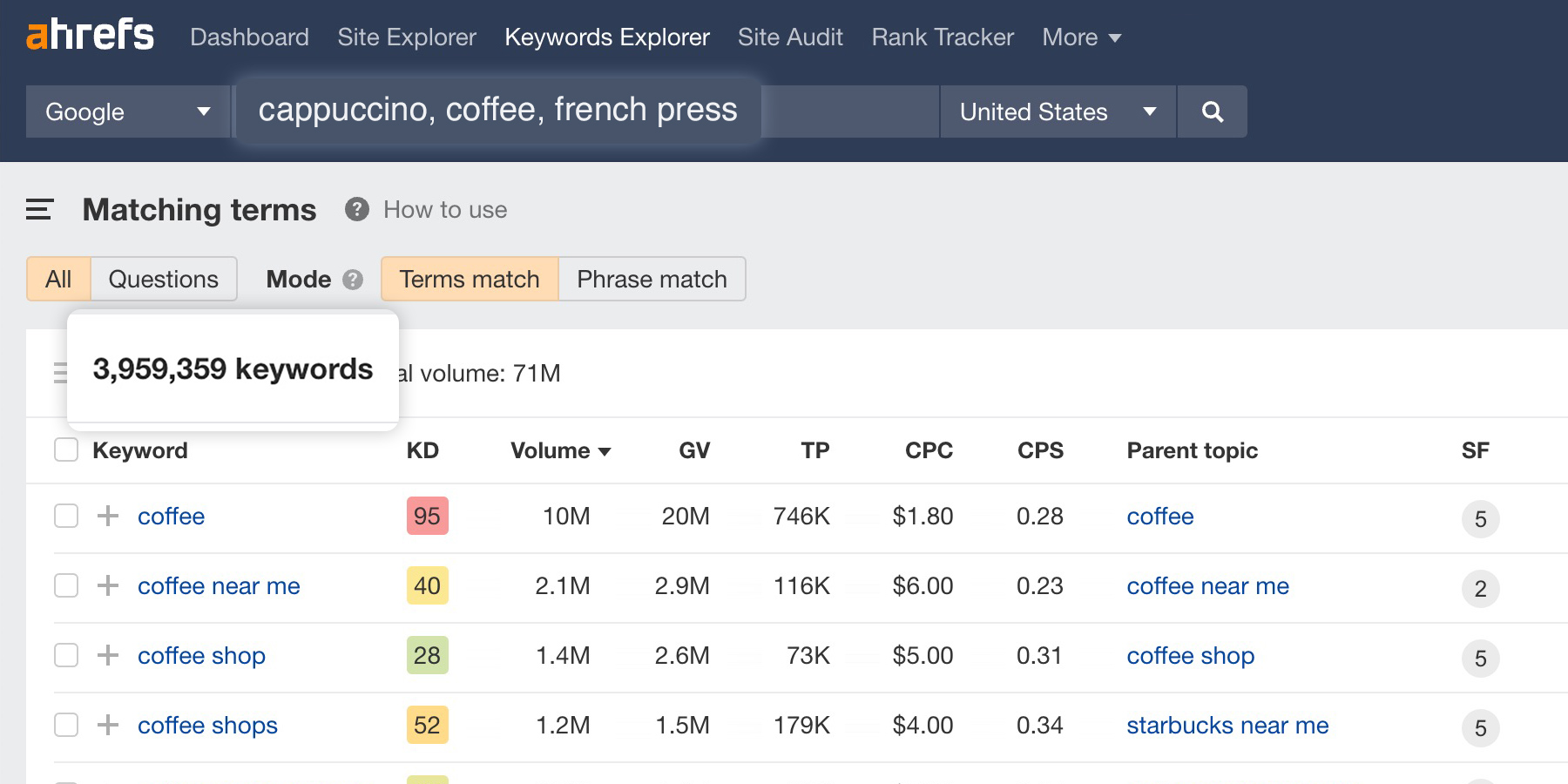Keyword research starts from putting yourself in the shoes of your customers. What words and phrases might they use to find solutions to their problems? Plug these into a keyword research tool like Ahrefs’ Keywords Explorer, and you’ll find thousands more relevant keyword ideas on top of what you just brainstormed.
It’s a simple process, but you need two things to do it well:
- Good knowledge of your industry
- An understanding of how keyword research tools work
That’s what this chapter is all about.
1. Brainstorm “seed” keywords
Seed keywords are the starting point of your keyword research process. They define your niche and help you identify your competitors. Every keyword research tool asks for a seed keyword, which it then uses to generate a huge list of keyword ideas (more on that shortly).
If you already have a product or business that you want to promote online, coming up with seed keywords is easy. Just think about what people type into Google to find what you offer.
For example, if you sell coffee and coffee-making equipment, then your seed keywords might be:
- coffee
- cappuccino
- french press
- nespresso
- etc
Note that seed keywords themselves won’t necessarily be worth targeting with pages on your website. As the name suggests, you’ll use them as “seeds” for the next steps in this process. So don’t obsess too much over your seed keywords. It should only take a few minutes to pinpoint them. As soon as you have a handful of broad ideas related to your website’s topic, move on to the next step.
2. See what keywords your competitors rank for
Looking at which keywords already send traffic to your competitors is usually the best way to accelerate your keyword research. But first, you need to identify those competitors. That’s where your brainstormed list of keywords comes in handy. Just search Google for one of your seed keywords and see who ranks on the front page.
If none of the top-ranking websites for your seed keywords resemble your site (or where you’re trying to take it), then you should try searching for slightly more specific things.
For example, if you sell coffee-making equipment on your website, you may find more actual competitors in the search results for “cappuccino maker” rather than “cappuccino.” That’s because there are mostly e-commerce stores like yours ranking for the former and blogs ranking for the latter.
Once you find a competitor website that fits the bill, you should plug it into a competitive intelligence tool like Ahrefs’ Site Explorer to check which pages bring it the most traffic and what keywords these pages are targeting.

After repeating the process with a few of your competitors, you’ll find yourself with a pretty sizable list of relevant keywords. And you’ve barely even started your keyword research!
Whether these keyword ideas are purely informational (i.e., blog articles) or have commercial intent (i.e., product pages) is something we’re going to determine in later stages of our keyword research process. For now, your goal is to collect as many relevant keyword ideas as you can.
Make sure to repeat this process for as many competitors as you can. We have a handy report in Site Explorer, which will help you discover more of them. It’s called “Competing Domains” and shows you similar websites to the one you’ve entered based on the common keywords that they rank for in Google.

ARE YOU SEEING A LOT OF TOPICS YOU’VE ALREADY COVERED?
If you’re doing keyword research for an established website, you may find that you’ve already covered most of your competitors’ keywords. In this case, you should try using the Content Gap report in Ahrefs’ Site Explorer. It finds keywords that one or more of your competitors rank for, but you don’t.
To use it, plug a few of your competitors’ websites into the top section, then paste your own site into the bottom field and click “Show keywords.”

3. Use keyword research tools
Competitors can be a great source of keyword ideas. But it’s very likely that there are many keywords that your competitors haven’t covered yet. You can find these using various keyword research tools.
Keyword research tools all work the same way. You plug in a seed keyword, and they pull keyword ideas from their databases based on that keyword.
Google Keyword Planner (GKP for short) is perhaps the most well-known keyword tool. It’s free to use, and although it’s made for people who want to display paid advertisements in Google, you can also use it to find keywords for SEO purposes.
Here are some keyword ideas that GKP has given me for the seed keyword “coffee”:

It is important to note that GKP is capable of generating keyword ideas that don’t necessarily contain your seed keyword in them. Take the keyword “percolator,” for example. Unless you’re a hardcore coffee connoisseur, you probably won’t know this relates to coffee. Which makes GKP quite a useful tool for discovering non-obvious keyword ideas.
And whenever you discover an interesting keyword like that, try using it as your new seed keyword and see what kind of new keyword ideas you’ll get from it.
Beyond Keyword Planner, there are quite a few other free keyword research tools. These are great if you’re just starting out, but you’ll soon realize that they’re quite limited in terms of data and functionality.
Thus, if you decide to commit to growing the search traffic to your website, you may as well skip the free tier and use a “professional” keyword research tool. Like Ahrefs’ Keywords Explorer.
Let’s enter a few of our seed keywords and see how many keyword ideas it gives us.

3.9 million keywords! No free tool will let you work with such a vast number of keyword ideas.
That may seem like an overwhelming number of keywords to work with. And it is. But don’t worry. You’ll learn how to narrow them down right in the tool later in this guide.
For now, let me briefly explain the differences between the two main types of keyword idea reports that we have in Keywords Explorer.
Matching terms
This report will only show you the keyword ideas that contain your seed keywords in them. It has two modes: “Terms match” and “Phrase match.”
“Terms match” shows keyword ideas that contain all words of your seed keyword in them, regardless of where exactly they are and what order they’re in. So if our seed keyword is “coffee machine,” we’ll get the following keyword ideas:
- coffee vending machine
- machine gun kelly coffee shop
“Phrase match” only returns keyword ideas that have the words of your seed keyword in the exact order as you entered them. Like so:
- best coffee machine
- coffee machine with grinder
Related terms
This report will show keyword ideas that don’t necessarily contain your seed keywords in them. It also has two modes: “Also rank for” and “Also talk about.”
- “Also rank for” shows you search queries that the top-ranking pages for your seed keyword also rank for.
- “Also talk about” shows you words and phrases that are frequently mentioned on the top-ranking pages for your seed keywords.
4. Study your niche
Everything we’ve discussed so far is enough to generate an almost unlimited number of keyword ideas. But at the same time, the process kind of keeps you “in the box.”
You can solve this by going to the places where your target audience hangs out—industry forums, groups, and Q&A sites—and studying their conversations.
For example, here’s a thread I found on the /r/coffee subreddit:

A quick check in Keywords Explorer, and I found this search query: “aeropress coffee to water ratio.” It only gets 150 searches per month, but the fact that this topic got 42 upvotes on Reddit means that people really appreciate this knowledge. Plus, the content of that Reddit thread can serve as a foundation for my future piece of content.
Other than browsing industry forums, your existing customers can also be a great source of keyword ideas. So the next time you talk to them, remember to pay attention to the language they use and the common questions they ask. That might lead you to some original keyword ideas to cover on your website.
Leave a Reply